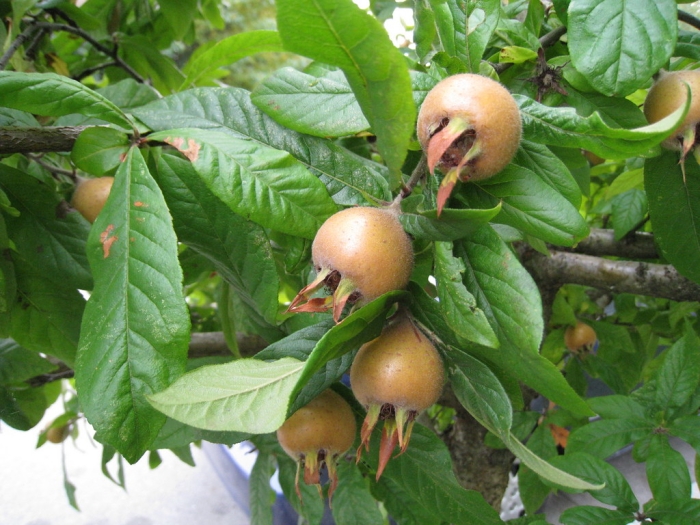Medlar
(Mespilus germanica)
Medlar (Mespilus germanica)
/
/

Wendy Cutler
CC BY-SA 2.0
Image By:
Wendy Cutler
Recorded By:
Copyright:
CC BY-SA 2.0
Copyright Notice:
Photo by: Wendy Cutler | License Type: CC BY-SA 2.0 | License URL: https://creativecommons.org/licenses/by-sa/2.0/ | Uploader: wlcutler | Publisher: Flickr |































































Estimated Native Range
Summary
Mespilus germanica, commonly known as the medlar or common medlar, is a deciduous large shrub or small tree, part of the rose family. Native to woodland margins and grasslands in Southeastern Europe and Southwest Asia, it has been cultivated since Roman times. The medlar fruit is notable for being consumed in winter when bletted (stored until soft). It can be eaten raw or used in various cooked dishes. The plant typically grows up to 8 m (26 ft) tall, though it often appears more shrub-like than tree-like, with a lifespan of 30–60 years. Medlar flowers very late in the season, around May or June, producing showy white flowers. The resulting fruit is a flattened, reddish-brown, hairy pome with juicy flesh. Medlars are valued for their unique fruit, historical significance, and ornamental qualities, including their attractive white blossoms.
Medlars prefer temperate and sub-Mediterranean climates with warm summers and mild winters, tolerating temperatures as low as −20 °C (−4 °F). They are resilient to late frosts and grow in a wide range of soil types, though they thrive in fresh, well-drained loamy soils with a pH between 6 and 8. In cultivation, they do best in full sun to part shade and require medium amounts of water. Medlars are often used in orchards, cottage gardens, and as specimen plants. They can suffer from fire blight and fruit tree canker, and require some maintenance to prevent these diseases.CC BY-SA 4.0
Medlars prefer temperate and sub-Mediterranean climates with warm summers and mild winters, tolerating temperatures as low as −20 °C (−4 °F). They are resilient to late frosts and grow in a wide range of soil types, though they thrive in fresh, well-drained loamy soils with a pH between 6 and 8. In cultivation, they do best in full sun to part shade and require medium amounts of water. Medlars are often used in orchards, cottage gardens, and as specimen plants. They can suffer from fire blight and fruit tree canker, and require some maintenance to prevent these diseases.CC BY-SA 4.0
Plant Description
- Plant Type: Tree
- Height: 15-20 feet
- Width: 15-20 feet
- Growth Rate: Moderate
- Flower Color: White
- Flowering Season: Summer
- Leaf Retention: Deciduous
Growth Requirements
- Sun: Full Sun, Part Shade
- Water: Medium
- Drainage: Slow, Medium, Fast
Common Uses
Bee Garden, Bird Garden, Edible*Disclaimer: Easyscape's listed plant edibility is for informational use. Always verify the safety and proper identification of any plant before consumption., Low Maintenance, Showy Flowers
Natural Habitat
Woodland margins and grasslands in Southeastern Europe and Southwest Asia
Other Names
Common Names: Common Medlar, Deutsche Mispel, Echte Mispel, Mispel
Scientific Names: , Mespilus germanica, Crataegus germanica, Pyrus germanica, Mespilus germanica var. germanica, Mespilus communis, Crataegus mespilus, Mespilus germanica var. macrocarpa, Mespilus germanica var. diffusa, Mespilus germanica var. sylvestris
GBIF Accepted Name: Mespilus germanica L.